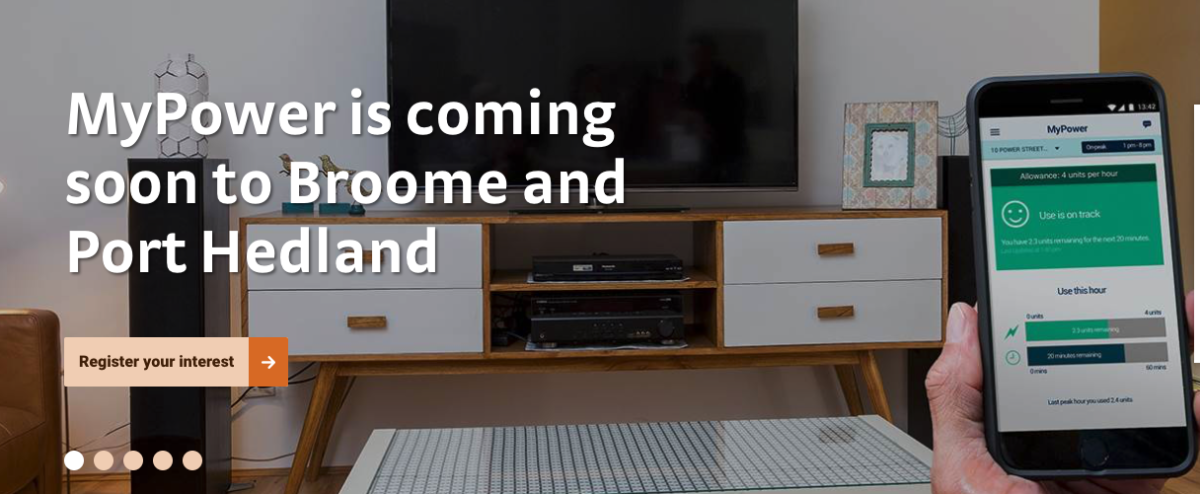Horizon Power is implementing its MyPower pricing structure in the regional towns of Broome and Port Hedland. The scheme aims to introduce more cost-reflective tariffs, by increasing fixed charges and providing incentives for consumers to reduce their consumption during peak demand periods.
MyPower will be opt in. It will provide a set quota of kilowatt hours during peak periods designated as between 1pm and 8pm each week day for residential customers. For commercial customers, the peak period will apply seven days a week. Public holidays are exempted from the peak quota for both businesses and households.
If a consumer can restrict their consumption to within that quota, they will receive a bonus on their bill. The bonuses are $300 and $900 a year for residential and commercial consumers respectively. It will be paid as a credit on the consumer’s electricity bill at the end of April.
Each consumer’s peak consumption plan will be generated individually, based on smart meter data, “their willingness to change their behaviour and information about the type of appliances they use,” according to a briefing document from Horizon Power.
Horizon Power has developed and made available a free app that consumers can use to monitor their electricity consumption. It will deliver alerts through push notifications to which consumers can respond.
Horizon says that by reducing peak demand, the state-owned utility pricing model will more accurately reflect the costs of supply. It will also bring down the generation and transmission costs of supplying the peak period.
Located in the northwest of the state, both Port Hedland and Broome experience very hot and humid conditions during the summer months, making air conditioning a necessity.
The regional utility, which supplies all Western Australian customers outside of the South-West Interconnected System (SWIS) is heavily subsidized by the West Australian taxpayer, with the costs of supplying some remote, rural and regional communities far beyond the costs of supply. Western Power tariffs are linked to prices in the SWIS – which encompasses the Perth metropolitan area.
“Horizon Power has led the way on pricing reform in Australia because we are in the unique position of having an advanced metering platform and delivering electricity across the supply chain, from generation to the customer,” said Frank Tudor, Horizon Power CEO.
“Changing customer behaviour through MyPower pricing plans is just part of the solution for reducing the cost of supply,” Tudor continued. “In addition to the discussion around pricing reform, the future is uncertain regarding customer consumption behaviour and the impact of the adoption of renewable technologies; customers not only want control of their electricity use, they want choice.”
Additionally, to the MyPower program, Horizon Power is deploying distributed renewable resources and new approaches to microgrids to a range of towns and communities across Western Australia.
Increased fixed charges and limiting peak supply will likely penalize consumers that have installed solar PV. During peak evening periods solar production is minimal, and the higher fixed charge will partly negate the savings delivered through reduced overall grid consumption delivered by a rooftop PV system.
In its MyPower briefing document Horzion acknowledges this, although notes that by covering the peak period through adding battery storage, consumers can save “hundreds of dollars a year” while on the MyPower plan.
MyPower is being rolled out after the trial Power Ahead program in Port Hedland. Horizon reports that the initiative demonstrated that when given the right price signals, consumers can change their behaviour bringing down overall costs.
This content is protected by copyright and may not be reused. If you want to cooperate with us and would like to reuse some of our content, please contact: editors@pv-magazine.com.









By submitting this form you agree to pv magazine using your data for the purposes of publishing your comment.
Your personal data will only be disclosed or otherwise transmitted to third parties for the purposes of spam filtering or if this is necessary for technical maintenance of the website. Any other transfer to third parties will not take place unless this is justified on the basis of applicable data protection regulations or if pv magazine is legally obliged to do so.
You may revoke this consent at any time with effect for the future, in which case your personal data will be deleted immediately. Otherwise, your data will be deleted if pv magazine has processed your request or the purpose of data storage is fulfilled.
Further information on data privacy can be found in our Data Protection Policy.